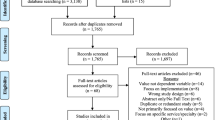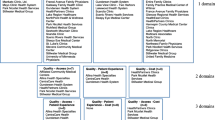Abstract
Focus in healthcare has been heralded as the next frontier in improving its efficiency and efficacy (Herzlinger 2004). Focus takes several different forms, ranging from standalone specialty centers to a hospital that places a strategic emphasis on a clinical area. We adopt this latter perspective and define focus as a disproportionate emphasis on a particular clinical area in a hospital. We use secondary data from hospitals providing cardiology care in New York State to examine the relationship between focus and performance. We develop two measures of focus. Proportional focus is defined to be the proportion of cases treated in a particular clinical specialty. Expertise focus is defined to be specific evidence that a hospital has taken action to build expertise in treating diseases in that specialty. We operationalize hospital performance along cost and quality dimensions, and we use hierarchical regression to examine the impact of focus on performance. Our results indicate that proportional focus, but not expertise focus, is associated with better cost performance. Quality performance, on the other hand, was associated only with the interaction between proportional focus and expertise focus, which means that only hospitals exhibiting higher levels of both proportional and expertise focus achieve better quality performance. These findings support the notion that not only is focus important in healthcare, but also that researchers and practitioners need to recognize that relationships are contingent on the performance and focus measures used and thus, findings may not be generalizable from one metric to another.
Similar content being viewed by others
Notes
The United States Government Accountability Office considers a hospital to be a specialty hospital if at least two-thirds of a hospital’s Medicare patients fall into no more than two major diagnosis categories according to the diagnosis-related group (DRG) classification, such as the diseases of the circulatory system, or if at least two-thirds of the patients were classified in surgical DRGs (United States Government Accountability Office 2005).
Hospitals-within-a-hospital are specialty hospitals that are physically located on the campus of a general hospital but are separately licensed and certified. They generally have independent facilities such as operating rooms, physical therapy suites, and pharmacies.
References
Aiken LS, West SG (1991) Multiple regression: testing and interpreting interactions. Sage, Newbury Park
Anderson SW (2001) Direct and indirect effects of product mix characteristics on capacity management decisions and operating performance. Int J Flex Manuf Syst 13:241–265
Ayanian JZ, Weissman JS (2002) Teaching hospitals and quality of care: a review of the literature. Milbank Q 80:569–593
Barro JR, Huckman RS, Kessler DP (2006) The effects of cardiac specialty hospitals on the cost and quality of medical care. J Health Econ 25:702–721
Berger PG, Ofek E (1995) Diversification’s effect on firm value. J Financ Econ 37:39–65
Centers for Medicare and Medicaid Services (2005) Study of physician-owned specialty hospitals required in Section 507(c)(2) of the Medicare Prescription Drug, Improvement, and Modernization Act of 2003 https://www.cms.gov/MLNProducts/Downloads/RTCStudyofPhysOwnedSpecHosp.pdf downloaded on 24 April 2011
Cleverley WO (1990) Improving financial performance: a study of 50 hospitals. Hospital Health Serv Admin 35:173–187
de Jong JD, Westert GP, Lagoe R, Groenewegen PP (2004) Variation in hospital length of stay: do physicians adjust their length of stay decisions to what is usual in the hospital where they work? Health Serv Res 41:374–394
Ginsburg PB (2000) Are focused factories the wave of the future? Front Health Serv Manage 16:41–46
Goldstein SM, Ward PT, Leong GK, Butler TW (2002) The effect of location strategy and operations technology on hospital performance. J Oper Manage 20:63–75
Gowrisankaran G, Town RJ (2003) Competition payers and hospital quality. Health Serv Res 38:1403–1421
Graham JR, Lemmon M, Wolf J (2002) Does corporate diversification destroy value? J Finance 57:695–720
Hainsworth DS, Lockwood-Cook E, Pond M, Lagoe RJ (1997) Development and implementation of clinical pathways for stroke on a multi-hospital basis. J Neurosci Nurs 29:156–162
Hannan E, Killburn H, Bernard H, O’Donnell J, Lukacik G, Shields E (1991) Coronary artery bypass graft surgery: the relationship between in hospital mortality rate and surgical volume after controlling for clinical risk factors. Med Care 29:1094–1107
Haunschild PR, Sullivan BN (2002) Learning from complexity: Effects of prior accidents and incidents on airlines’ learning. Adm Sci Q 47:609–643
Health Care Investment Analysts Inc. (1995) Directory of US Hospitals HCIA Baltimore MD
Herzlinger R (1997) Market driven health care. Addison Wesley, Reading
Herzlinger R (2004) Consumer driven health care: implications for providers payers and policy makers. Jossey Bass, San Francisco
Heskett JL (1983) Shouldice Hospital Limited. Harv Bus Sch Case 9-683-068. Harv Bus Sch Publ: Boston MA
Huckman RS, Pisano GP (2006) The firm specificity of individual performance: evidence from cardiac surgery. Manag Sci 52:473–488
Huckman RS, Zinner DE (2007) Does focus improve operational performance? Lessons from the management of clinical trials. Strat Manag J 29:179–193
Hyer NL, Wemmerlov U, Morris JA (2009) Performance analysis of a focused hospital unit: the case of an integrated trauma center. J Oper Manage 27:203–219
Jaccard J, Choi KW, Turrisi R (1990) The detection and interpretation of interaction effects between continuous variables in multiple regression. Multivariate Behav Res 25:467–478
Jha AK, Orav EJ, Dobson A, Book R, Epstein AM (2009) Measuring efficiency: the association of hospital costs and the quality of care; Are the goals of quality improvement and cost reduction complementary to or in competition with one another? Health Aff 28:897–906
Johnson T (2010) Healthcare costs and U.S. competitiveness. http://www.cfr.org/publication/13325/healthcare_costs_and_us_competitiveness.html
Kunst P, Lemmink J (2000) Quality management and business performance in hospitals: A search for success parameters. Total Qual Manage 11:1123–1133.
Lagoe RJ, Noetscher CM, Murphy ME (2001) Hospital readmission: predicting the risk. J Nurs Care Qual 15:69–83
Lang LH, Stulz RM (1994) Tobin’s q corporate diversification and firm performance. J Pol Econ 102:1248–1280
McKay NL, Deily ME (2005) Comparing high- and low-performing hospitals using risk-adjusted excess mortality and cost inefficiency. Health Care Manage Rev 30:347–360
McLaughlin CP, Yang S, van Dierdonck R (1995) Professional service organizations and focus. Manage Sci 41(7):1185–1193
Mukherjee A, Mitchell W, Talbot FB (2000) The impact of new manufacturing requirements on production line productivity and quality at a focused factory. J Oper Manage 18:139–168
New York State Commission on Healthcare Facilities in the 21st Century (2007) Qual Healthc http://www.nyhealthcarecommission.org/docs/quality.pdf downloaded on 22 February 2011
Noetscher CM, Morreale GF, Lagoe RJ (2001) Length of stay reduction: two innovative hospital approaches. J Nurs Care Qual 16:1–14
Pasley BH, Lagoe RJ, Marshall NO (1995) Excess acute care bed capacity and its causes: the experience of New York State. Health Serv Res 30:115–131
Pisano G, Bohmer R, Edmondson A (2001) Organizational differences in rates of learning: evidence from the adoption of minimally invasive cardiac surgery. Manage Sci 47:752–768
Porter ME (1980) Competitive strategy. Free Press, New York
Porter ME, Teisberg EO (2006) Redefining health care: creating value-based competition on results. Harv Bus Sch Press, Boston
Robinson JC, Luft HS (1985) The impact of hospital market structure on patient volume average length of stay and the cost of care. J Health Econ 4:293–391
Rogowski JA, Horbar JD, Staiger DO, Kenny M, Carpenter J, Geppert J (2004) Indirect vs direct hospital quality indicators for very low-birth-weight infants. JAMA 291:202–209
Skinner W (1974) The focused factory. Harv Bus Rev 52(3):113–122
Skinner W (1969) Manufacturing—missing link in corporate strategy. Harv Bus Rev 47:136–145
Smith A (1776) An inquiry into the nature and causes of the wealth of nations. Methuen, London
Smith HL, Fottler MD, Saxberg BO (1981) Cost containment in health care: a model for management research. Acad Manage Rev 6:397–407
Taylor FW (1911) The principles of scientific management (reprinted 2005). First World Library, Fairfield
Tsikritsis N (2007) The effect of operational performance and focus on profitability: a longitudinal study of the U.S. airline industry. Manuf Serv Oper Manag 9:506–517
United States General Accounting Office (2003) Specialty hospitals: Information on national market share physician ownership and patients served. Washington D.C.
United States Government Accountability Office (2005) Specialty hospitals: Information on potential new facilities. Washington D.C.
Vokurka RJ, Davis RA (2000) Focused factories: empirical study of structural and performance differences. Prod Invent Manage J 41:44–55
Author information
Authors and Affiliations
Corresponding author
Appendix. Example Calculation of Percentage Difference from Expected Mortality Rate
Appendix. Example Calculation of Percentage Difference from Expected Mortality Rate
For one hospital, for APR-DRG = 190 (acute myocardial infarction) the expected mortality rate is computed in the following manner:
Risk Subclass | Cases | Deaths | Subclass State Average Mortality Rate | Weight | Subclass Weighted Average Mortality Rate |
|---|---|---|---|---|---|
1 | 21 | 0 | 0.0034 | 21/137 = 0.153 | 0.153*.0034 = 0.0005 |
2 | 43 | 1 | 0.0184 | 0.314 | 0.0058 |
3 | 40 | 4 | 0.1120 | 0.292 | 0.0327 |
4 | 33 | 13 | 0.4172 | 0.241 | 0.1005 |
Totals | 137 | 18 | 0.1395 |
Individual weights are calculated by dividing the number of cases in a subclass by the total number of cases, so for the risk subclass 1, the weight would be calculated as:
The weighted average mortality rate for each subclass is calculated by multiplying the state average by the weight, so for subclass 1, the weighted average would be calculated as:
The expected mortality rate is then calculated by summing the individual subclass weighted average values. In this example, the expected mortality rate:
The observed mortality rate is simply the total number of deaths divided by the total number of cases:
The mortality rate performance variable (percent difference from expected mortality rate) is then calculated as follows:
In this example, the percent difference from expected mortality rate would be calculated as:
This hospital’s actual observed mortality rate for this APR-DRG is therefore 5.81% lower than the mortality rate expected given its mix of cases. Negative values indicate an observed mortality rate that is lower than expected; consequently lower values indicate better performance. The overall expected and observed mortality rates for a hospital are calculated by aggregating expected and observed mortality rates, respectively, for all APR-DRGs, and the overall percentage difference from expected mortality rate is calculated by using the overall observed mortality rate and overall expected mortality rate in the formula above. Similarly, we use the percent difference from expected costs as a measure of the cost performance for the hospital. We compute the risk adjusted difference in cost measure as \( \left( {{\text{Observed}}\,{\text{costs}} - {\text{Expected}}\,{\text{costs}}} \right)/\left( {{\text{Expected}}\,{\text{costs}}} \right) \).
Rights and permissions
About this article
Cite this article
McDermott, C.M., Stock, G.N. & Shah, R. Relating focus to quality and cost in a healthcare setting. Oper Manag Res 4, 127–137 (2011). https://doi.org/10.1007/s12063-011-0053-7
Received:
Revised:
Accepted:
Published:
Issue Date:
DOI: https://doi.org/10.1007/s12063-011-0053-7




